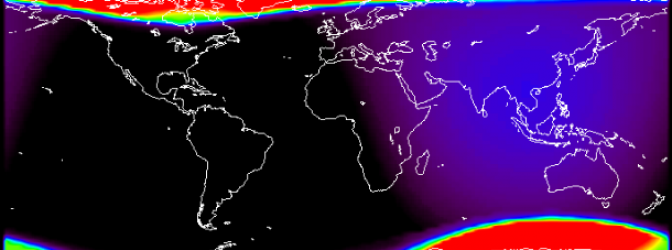G1 (Minor) Geomagnetic Storm in progress – May 18, 2013

G1 (Minor) Geomagnetic Storm conditions are now occurring due to the arrival of the CME from May 15, 2013. During G1 Geomagnetic Storm, weak power grid fluctuations can occur, minor impact on satellite operations is possible, aurora is commonly visible at high latitudes and migratory animals are affected at this and higher levels.
Planetary K-index reached Kp=5 level. This series of CME's related to AR 1748 had a source region within 30 degrees of the solar limb, which reduces their possibility of arrival to the Earth to around 30%.
.png)
ALERT: Geomagnetic K-index of 5
Threshold Reached: 2013 May 18 0300 UTC
Synoptic Period: 0300-0600 UTC
Active Warning: Yes
NOAA Scale: G1 – MinorSUMMARY: Geomagnetic Sudden Impulse
Observed: 2013 May 18 0112 UTC
Deviation: 31 nT
Station: Boulder
Proton levels (10MeV) are still above threshold, stable around 3 protons/cm2-s-sr. Geomagnetic conditions have been unsettled to active, due to long lasting periods of slow solar wind with sustained mild negative Bz (around -5nT). Currently, the Bz component of the interplanetary magnetic field (IMF) is tipped south.
.png)
Active Region 1748 erupted once again, this time with M 3.2 solar flare associated with the CME, at 08:57 UTC on May 17, 2013. The current Solar Radiation Storm is expected to stay at category S1 (Minor), although the proton flux may increase slightly with the passage of the shock driven by the CME.

Sunspot 1748 released two M-class flares in past 36 hours. The first one occurred on May 16, 2013 at 21:53 UTC, registered as M1.3. The second flare was an M3.2 and peaked at 08:57 UTC on May 17, 2013 and was related to R1 (Minor) Radio Blackout and a CME. CME is seen in STEREO COR2 data, and it looks like it's Earth-directed. The speed in COR2-B is calculated to be 1300 km/s, making a possible arrival to the Earth on May 19, 2013.
Active Region 1748 still has potential for producing X-class flares. It maintains its Beta-Gamma-Delta magnetic configuration, even though some fragmentation is seen in the trailing region and there are some indications that polarities are separating within the delta spot penumbra.
Featured image: NOAA/SWPC

Commenting rules and guidelines
We value the thoughts and opinions of our readers and welcome healthy discussions on our website. In order to maintain a respectful and positive community, we ask that all commenters follow these rules:
We reserve the right to remove any comments that violate these rules. By commenting on our website, you agree to abide by these guidelines. Thank you for helping to create a positive and welcoming environment for all.